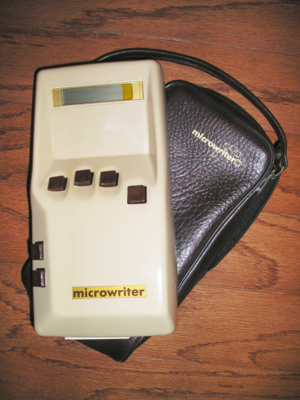This is an old revision of this page, as edited by Miremare (talk | contribs) at 19:14, 25 July 2008 (tense). The present address (URL) is a permanent link to this revision, which may differ significantly from the current revision.
Revision as of 19:14, 25 July 2008 by Miremare (talk | contribs) (tense)(diff) ← Previous revision | Latest revision (diff) | Newer revision → (diff)| This article does not cite any sources. Please help improve this article by adding citations to reliable sources. Unsourced material may be challenged and removed. Find sources: "Microwriter" – news · newspapers · books · scholar · JSTOR (January 2008) (Learn how and when to remove this message) |
The Microwriter is a hand-held portable word-processor with an innovative chording keyboard. It was sold in the early 1980s by Microwriter Ltd, of London, UK.
 |
The Microwriter MW4
The MW4 Microwriter is believed to be the only model sold in any significant quantity. The 23 cm x 12 cm x 5 cm device comprises:
- A six-button chording keyboard.
- A single line LCD display.
- An 8 bit microprocessor.
- Complete Word processing software in ROM.
- 16 kilobytes of RAM.
- Rechargeable Nickel-cadmium batteries - sufficient to run the device for several hours.
- Various interfaces (see below).
This device is capable of allowing the user to enter and edit several pages of text - and by connecting a printer to the RS-232 serial port connector, documents can be printed without the aid of a separate computer.
Keyboard
The innovative keyboard uses one button for each finger and two for the thumb of the user's right hand. The five buttons immediately beneath the fingers are pressed in different combinations to generate the letters A through to Z. The second thumb button is used to toggle through a range of modes that allow the user to switch case, enter numbers, insert punctuation and even add ASCII control characters, to be used in editing the document being prepared. To type a letter "T", for example, the user would tap the top thumb button to shift to uppercase, then chord a "t" by pressing the index finger and ring finger buttons simultaneously.
This unusual keyboard is surprisingly easy to use. The manufacturers claimed that most people could learn to use it in just a couple of hours. With a little practice, it is possible to become a faster typist with the Microwriter than with a conventional keyboard, providing that what is being entered is just text. Things slow down a lot if a substantial number of special characters have to be entered using the "shifting" mechanism.
Learning the chords for the basic letters and numbers is facilitated by a set of flash-cards that show simple mnemonics for each character.
External ports
At the top end of the unit is a 25 pin D-type connector providing an RS-232 port, an interface to an audio cassette player for saving and restoring files and a small white on/off button. At the other end is the connector for the battery charger and a 37 pin D-type connector that can be hooked up to an optional external unit to allow the Microwriter to be connected to a television and thus to perform full-screen editing. The serial port can be used to connect the Microwriter directly to a printer, or to allow it to be plugged into a computer to function in place of the conventional keyboard.
The fate of the Microwriter
The Microwriter was an innovative product, and was endorsed by writer Douglas Adams. Despite the fact that there was no similar product on the market, the Microwriter was not a great success, and ceased production in 1985. It is likely that the concept of a chording keyboard put off many potential customers, although users of the device reported that, in practice, they could learn to use it to an acceptable standard after just one or two hours of training, with proficiency taking a few days.
A cut-down version of the Microwriter, known as the "Quinkey", was sold as a keyboard add-on for the BBC Micro computer. It came with a game that helped the user to learn the chords. There were two versions of the interface software, one optimised for entering BBC BASIC commands, the other for word processing.
A modified five-key version of the Microwriter chording scheme was later provided on the AgendA handheld device, an early PDA, which also used a main normal keyboard. A modern equivalent, the CyKey, is currently sold by Chris Rainey, co-inventor of the Microwriter. This is an ambidextruous chord keyboard, with three groups of three keys, which can be used as a controller keyboard for PCs or a PDA. Unlike the original Microwriter it does not include built-in software.
Microwriter AgendA
The Microwriter AgendA is claimed to be the first useful PDA. It includes a set of small "conventional" keys arranged inside the half circle of a Microwriter chording keyboard with larger keys. Offering 32k of storage, pluggable memory modules, a 4-line LCD screen, excellent build quality and long battery life, it is a capable device for text-mode note-taking without needing a conventional desk or keyboard. In 1990 it was awarded the British Design Award.
Interface cables were available for the common serial (RS-232) and parallel (printer) ports of the day. These use a "smart" cable connected to a single interface on the AgendA that is actually an I²C bus. This interface, together with the AgendA's rugged construction, led to them even being used as industrial portable calibration terminals for I²C-equipped factory machines.
See also
External links
- "MicroWriter Codes". Bellaire.
- ^ AgendA
| Keyboard layouts | |||||||
|---|---|---|---|---|---|---|---|
| Latin script (list) |
| ||||||
| Non-Latin script |
| ||||||
| For mobile devices |
| ||||||
| Chorded keyboards |
| ||||||
| Standards | |||||||
| Historical | |||||||